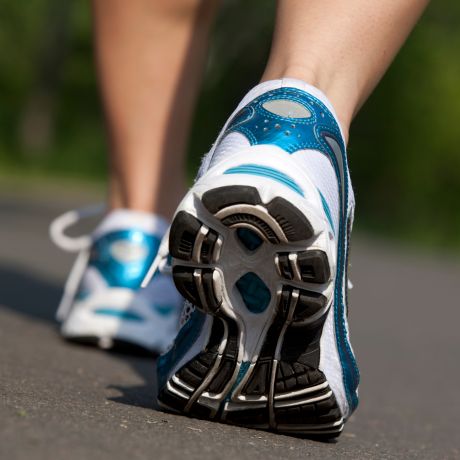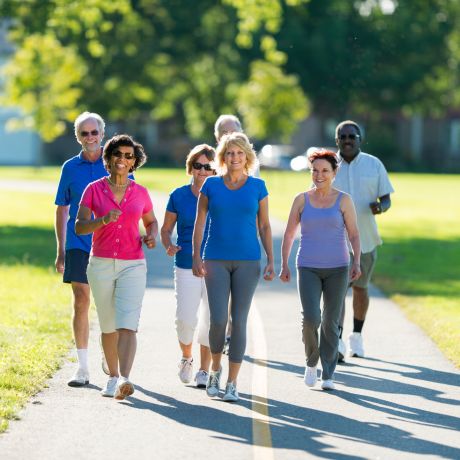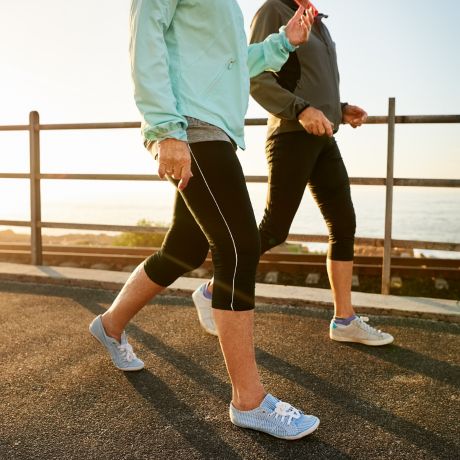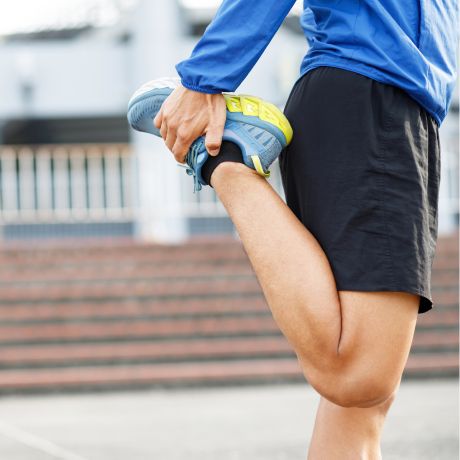Want your perfect workout program?
Take QuizWhat Can Walking For 1 Hour Everyday Do For You? My Experience

Written by Andrew Lenau | ISSA CPT & Sports Nutritionist
Fact checked by Tyler DiGiovanni, BSBM
 FACT CHECKED
FACT CHECKED
In today's busy world, finding time for exercise or working out can feel like an impossible task. However, what if I told you that just one hour a day could potentially change your life for the better? Walking, a simple and easily accessible form of exercise, has been proven to have many physical and mental health benefits.
In fact, I have been walking an hour a day for almost five years now, so I know firsthand the benefits you can experience when you start walking every day. This article will explore the incredible mental and physical health effects of walking one hour a day for a month, backed by my personal experiences, other people's success stories, scientific research, and practical tips for getting started.
Table of Contents
- My Experience Walking One Hour a Day For a Month
- Other Daily Waking Success Stories
- The Physical Benefits of Walking One Hour a Day
- The Mental Benefits of Walking One Hour a Day
- How To Get Started And Tips for a Successful 30-Day Walking Challenge
- Safety Concerns and Precautions To Take
- Outro

My Experience Walking One Hour a Day For a Month
For many, the idea of committing to walking for an hour every day might seem like a daunting task. Me included. However, I decided to take on the challenge and push myself to do something outside my comfort zone.
Each day, regardless of whether it is raining or shining, I finish training my morning clients and hit the pavement. The initial struggle was finding the motivation actually to do it. Still, over the course of a couple of weeks, I started to enjoy the time outside, and I discovered that my mental and physical well-being improved significantly.
As the days progressed, I started to notice increased energy levels, better moods, and even improved sleep quality. Walking became not just a form of exercise but also a therapeutic way for me to take a break from the stresses of my everyday life and allowed me to put my phone away for an hour.
It is worth mentioning that you don't have to walk outside every day for that hour; that was a personal challenge for me and not something I recommend to everyone. If the weather is bad or you just don't feel like walking outside, I recommend walking on a treadmill.
Related: Manual vs Electric Treadmill

Other Daily Walking Success Stories
While my journey is just one example, countless others on Reddit and other websites have experienced similar or even more remarkable transformations through daily walking, from weight loss success stories about how they saw improved mental health and overall well-being.
Take u/jefferson_waterboat from Reddit, who said, "I started walking in January, that led me to start counting my calories, that led me to start trying to eat more healthily, and I've lost 44 lbs. I do go for runs now because I can, but starting out for the first 2 months I really couldn't, the calorie burn from walking has been huge, but it's the time spent walking thinking about my health that led to other good decisions in my life."¹
Or this user, u/Itslateyall, who struggled for nine years until she started walking "Hi everyone. Idk who this might encourage, but I wanted to say that after 9 years of no meaningful changes I have found my solution. Walking! My appetite has naturally changed AFTER I decided a few months ago to walk 3 miles a day or about one hour most days of the week. I'm 37 yo female with multiple pregnancies. My legs feel so strong and I am less tired. I don't have the patience or time to obsess over foods but I do make good choices throughout the day like less sugar. If you're tired of trying to figure out the formula might I suggest just walking. I've lost 20lbs so far"²

The Physical Benefits of Walking One Hour a Day
Walking is often underrated as a form of exercise, but the benefits are undeniable for individuals who are getting started or just want more physical exercise. Unlike more complicated activities, such as running or weightlifting, walking is low-impact and accessible to individuals of all ages and fitness levels.
Here is a list of the biggest benefits you can experience walking an hour a day for a month.
1. Cardiovascular Health Improvement
Walking consistently can help to improve cardiovascular health by increasing heart rate and circulation. This increase in heart rate and circulation, in turn, lowers blood pressure and lowers the risk of heart disease, stroke, and other conditions. Walking strengthens the heart by promoting better blood flow and oxygen delivery throughout the body's tissues. It improves its efficiency, which in studies has been shown to decrease the chances of getting a cardiovascular disease.³
2. Weight Management and Metabolism Boost
Walking is an easy and effective way to prevent obesity-related conditions like diabetes, heart disease, and high blood pressure. Even if you can only hold a moderate pace, walking can burn many calories, making it an excellent weight loss and maintenance tool.⁴
3. Muscle Strength and Endurance
Walking isn't just a cardio workout; it also engages quite a few muscle groups, including the legs, core, and upper body, which can significantly improve muscle strength and endurance over time. As you get stronger, start incorporating hills, stairs, or resistance bands into your walking routine to challenge your muscles further.
4. Bone Health and Density
Walking is an exercise that helps strengthen bones and can even prevent bone loss associated with aging and conditions like osteoporosis. By putting good stress on the bones through walking, the body is able to make the bones stronger and less susceptible to fractures and breaks.⁵
5. Joint Health and Flexibility
Contrary to what many people say, walking is a type of exercise that is easy on the joints and can help improve joint health, reduce pain, and increase flexibility. Walking helps to lubricate the joints, reducing stiffness and inflammation and promoting a better range of motion.⁶
6. Improved Digestion and Bowel Function
One of the biggest things I get from walking daily is that walking stimulates digestion and bowel function by increasing blood flow to the digestive organs. This can help to reduce and even alleviate constipation and promote regularity.⁷

The Mental Health Benefits of Walking One Hour a Day
Besides the physical benefits you can see when you walk an hour a day, it can also positively affect mental health and well-being. There have been studies conducted that have shown that regular walking can reduce stress, anxiety, and depression while improving mood and cognitive function.
These benefits can be improved even more by simply walking outdoors. So, connecting with nature can positively affect your mental well-being.
1. Stress Reduction and Relaxation
One of my favorite parts about walking is that it is a natural stress reliever. This can help reduce cortisol levels, the body's primary stress hormone, and increase feelings of relaxation, improved mood, and calmness.⁸
I try to make sure that I turn my phone on silent, and for the entire hour, I focus on the sights and sounds of nature, which distract my mind from worries and negative thoughts.
2. Enhanced Cognitive Function and Brain Health
While I didn't really see significant improvements in this area, walking has been shown to improve cognitive functionality and brain health by increasing blood flow to the brain and increasing the growth of new neurons, particularly in areas associated with memory and learning.⁹
This can lead to better concentration, focus, problem-solving skills, and reduced risk of cognitive decline and dementia later in life.

How To Get Started And Tips for a Successful 30-Day Walking Challenge
If you're inspired to try and take on the 30-day walking challenge, here are some of the biggest tips I give people to make sure that you start on the right foot and increase their chances of success.
1. Start Slow and Gradually Increase Intensity
If you're just starting with physical exercise, I would recommend starting slow with shorter walks at a comfortable pace and gradually increasing duration and intensity over time. Keep building the duration until you walk for the entire hour every day.
Building yourself up slowly allows your body to adjust to the increased activity and reduces the risk of injury or burnout.
2. Invest in Proper Footwear
I'll be honest: I don't typically spend a lot of money on my shoes. At the beginning of my walking journey, I wore a cheap pair of tennis shoes that were well past their prime, resulting in a ton of swelling and pain in the arches of my feet.
Buying a good pair of walking shoes is something I highly recommend to people because they help to provide a comfortable, injury-free walking experience. Look for shoes meant for walking/running that provide adequate support, cushioning, and stability, and choose a size that allows room for your feet to swell slightly during longer walks.
If you're unsure what shoes to get, consider visiting a specialty shoe store for a professional fitting to ensure you find the perfect pair for your needs.
3. Choose Safe and Enjoyable Routes
Choose safe and scenic routes that keep you inspired, excited, and motivated to keep walking. My favorite places are usually local parks, nature trails, or just hitting the road around my home.
Find environments that offer variety in terrain and scenery. I also enjoy walking in areas within a walking group as it motivates me to work harder, and it is nice to meet new people.
4. Track Your Progress
During your 30-day walking challenge, you're going to make progress, and it would be a good idea to track your progress along the way. The easiest and best way to track your progress is by using a health or fitness tracker or app to monitor your daily steps, distance, and calories burned.
By recording these things, you can easily see the improvements you've been making and celebrate the small victories along the way to keep you motivated and inspired.
5. Listen to Your Body and Prioritize Rest
To successfully complete the one-month challenge, you need to walk every day for an hour, with no breaks. However, you still need to listen to your body. If it is begging for a day off, I would recommend prioritizing rest and recovery as needed.
Also, suppose you begin to experience any pain or discomfort during your walks. In that case, the challenge isn't worth getting hurt over, and I would say that you should take a break and allow your body to heal before resuming activity.

Safety Concerns and Precautions To Take
Walking is a relatively safe form of exercise. However, taking certain precautions to avoid injury and stay safe while walking is still essential. Some of the easiest things to focus on include wearing appropriate footwear, staying hydrated, and being aware of your surroundings.
Before starting a walking challenge, consult your healthcare professional to see if you are healthy enough to exercise or have any underlying health conditions or concerns.
1. Stay Hydrated and Fuel Your Body
Staying hydrated is incredibly important when walking, especially during hot weather or longer walks. Just like with most forms of exercise, drink plenty of water before, during, and after your walks to prevent dehydration and maintain peak performance.
I typically bring a backpack with me so that I can carry my water bottle on my walks; another good idea would be to plan your route around water fountains or restrooms where you can refill your bottle as needed. If you're going to go on an exceptionally long walk, I would highly recommend bringing healthy snacks and maybe some electrolyte packets to provide energy and support recovery.
2. Be Aware of Your Surroundings
Most of my walks are done out in nature, so I always have to be aware of my surroundings and take precautions to ensure my safety while walking. Typically, I make sure to give myself plenty of daylight and go to pretty well-traveled routes.
I recommend looking for well-lit and populated routes, especially when walking alone or in unfamiliar areas, and avoiding isolated or poorly lit areas where you may be at greater risk of encountering potential dangers. If you live in the city or populated areas, pay attention to traffic, pedestrians, and cyclists, and of course, follow traffic signals and signs when crossing streets or intersections.
3. Warm-Up
While it isn't the most exciting thing in the world, stretching before you walk can prepare your body for the activity ahead, helping to prevent injuries and improve flexibility.
Here are a few simple stretches I do every day before my walk and think that you should incorporate into your warm-up routine:
Calf Stretch:
- Stand towards a wall with one foot forward and one foot back.
- Keep your back leg straight and your heel on the ground as you lean forward, feeling a stretch in your calf muscle.
- Hold for 15-30 seconds, then switch legs.
Hamstring Stretch:
- Sit on a flat surface with one leg extended and the other slightly bent, foot flat on the floor.
- Lean forward, reaching towards your toes while also keeping your back straight.
- Hold for 15-30 seconds, then switch legs.
Quadriceps Stretch:
- Stand tall with feet hip-width apart.
- Bend one knee and bring your heel towards your buttocks, grasping your ankle with your hand.
- Gently pull your heel towards your buttocks until you feel a stretch in the front of your thigh.
- Hold for 15-30 seconds, then switch legs.
To get the most out of your stretches, take your time with each stretch, focusing on slow, controlled movements and breathing deeply. It is best to avoid bouncing or jerking movements, as this can cause injury. Always listen to your body and only stretch to the point of mild tension, never to the point of being in pain.

Frequently Asked Questions
How Many Calories Can You Burn By Walking For An Hour Each Day?
The number of calories you can burn during a walk depends on factors like body weight, walking speed, and the terrain. You can expect to burn roughly 200-300 calories per hour if you can keep a brisk pace.
To maximize how many calories you burn every time you walk, maintain a brisk walking pace that elevates your heart rate and challenges your muscles. You can also try incorporating intervals of higher intensity, such as walking uphill or adding short bursts of added speed, which can also help increase how many calories you burn.
Regardless of how much you walk, the calories you burn are only one aspect of weight management. Combining regular exercise with a balanced diet and other healthy lifestyle habits is just as important to achieving weight loss or maintenance.
How long does it take to see results from walking an hour a day?
Results from walking can vary depending on individual factors. Still, many people start to notice slight improvements in their energy levels, mood, and overall fitness within just a couple of weeks of consistent walking. However, the timeline for seeing more significant changes, such as weight loss or muscle toning, may vary from person to person.
You can expect to see more significant improvements in cardiovascular health, endurance, and stamina within the first month of starting a walking routine. As time goes on, you may also start to see changes in body composition, such as reduced body fat and increased muscle tone.
If you want to see results faster, I recommend combining walking with other forms of exercise, such as strength training or yoga.
Can I lose belly fat by walking 1 hour a day?
If you're just trying to focus on losing belly fat, then I hate to tell you, but spot reduction isn't possible. However, regularly walking can help reduce overall body fat, including belly fat, when combined with a healthy diet and lifestyle.
To fully maximize fat loss, lose weight, and achieve a trimmer waistline, focus on creating a calorie deficit by combining walking and strength training with a balanced diet that includes plenty of fruits, vegetables, lean proteins, and whole grains. Also, trying to limit your intake of processed foods, sugary beverages, and excess calories can help prevent gaining belly fat and promote weight loss.
Outro
Some may say that walking is too easy of an exercise, but in my experience, you can improve your life with an hour of walking a day. You'll start to see significant changes in your body, fitness, and mental health.
The improvements you will see will probably motivate you to continue the challenge well after you're done, so why not take the first step, get outside of your comfort zone, and take the challenge of walking an hour a day for a month?
Citations:
- alasfinallyaname. Will Walking One Hour a Day Actually Do Anything? 28 Mar. 2023, www.reddit.com/r/WeightLossAdvice/comments/1252tbt/will_walking_one_hour_a_day_actually_do_anything/
- Itslateyall. Walking an Hour a Day. 22 Nov. 2023, www.reddit.com/r/loseit/comments/181bdzy/walking_an_hour_a_day/.
- Murtagh, Elaine M, et al. "Walking: The First Steps in Cardiovascular Disease Prevention." Current Opinion in Cardiology, U.S. National Library of Medicine, 25 Sept. 2010, www.ncbi.nlm.nih.gov/pmc/articles/PMC3098122/.
- Najafian, Jamshid, et al. "Relation between Usual Daily Walking Time and Metabolic Syndrome." Nigerian Medical Journal : Journal of the Nigeria Medical Association, U.S. National Library of Medicine, Jan. 2014, www.ncbi.nlm.nih.gov/pmc/articles/PMC4071659/.
- Author links open overlay panelElizabeth A. Krall Ph.D., et al. "Walking Is Related to Bone Density and Rates of Bone Loss." The American Journal of Medicine, Elsevier, 17 June 2004, www.sciencedirect.com/science/article/abs/pii/0002934394901112#:~:text=results%3A%20Women%20who%20walk%20more,reflective%20of%20lifelong%20walking%20habits.
- Alghadir, Ahmad H., et al. "Effect of 6-Week Retro or Forward Walking Program on Pain, Functional Disability, Quadriceps Muscle Strength, and Performance in Individuals with Knee Osteoarthritis: A Randomized Controlled Trial (Retro-Walking Trial)." BMC Musculoskeletal Disorders, vol. 20, no. 1, 9 Apr. 2019, https://doi.org/10.1186/s12891-019-2537-9.
- Hosseini-Asl, Mohammad Kazem, et al. "The Effect of a Short-Term Physical Activity after Meals on Gastrointestinal Symptoms in Individuals with Functional Abdominal Bloating: A Randomized Clinical Trial." Gastroenterology and Hepatology from Bed to Bench, vol. 14, no. 1, 2021, pp. 59–66, www.ncbi.nlm.nih.gov/pmc/articles/PMC8035544/.
- Edwards, Meghan K., and Paul D. Loprinzi. "Experimental Effects of Brief, Single Bouts of Walking and Meditation on Mood Profile in Young Adults." Health Promotion Perspectives, vol. 8, no. 3, 7 July 2018, pp. 171–178, www.ncbi.nlm.nih.gov/pmc/articles/PMC6064756, https://doi.org/10.15171/hpp.2018.23.
- Kang, Suh-Jung, et al. "The Beneficial Effects of Cognitive Walking Program on Improving Cognitive Function and Physical Fitness in Older Adults." Healthcare, vol. 9, no. 4, 5 Apr. 2021, p. 419, https://doi.org/10.3390/healthcare9040419.

Also in Blog
Recent Articles
-
Calories In, Calories Out Myth: Fact or Fiction?April 08, 2025
-
Cardio Or Strength Training: What's Better For Weight Loss?April 03, 2025
Must Reads
-
Mr Olympia 2024: What to Expect This Year (Oct. 10-13, 2024)September 11, 2024
-
The Ultimate "Bro Split" Workout Plan (Backed By Science)August 05, 2023
- Blog
- Exercises
- Workouts
- Meal Plans
- SFS Programs
- Apparel
- About Us
- FAQ
- Shipping
- Warranty
- Contact Us
- Terms & Conditions
- Privacy Policy
- Affiliates
- SFS UGC Policy
- SFS MBG Policy
- Disclosures
- Legal Disclaimer
Sign up to get the latest on sales, new releases and more…
© 2025
SET FOR SET.
Powered by Shopify















Andrew Lenau
Author